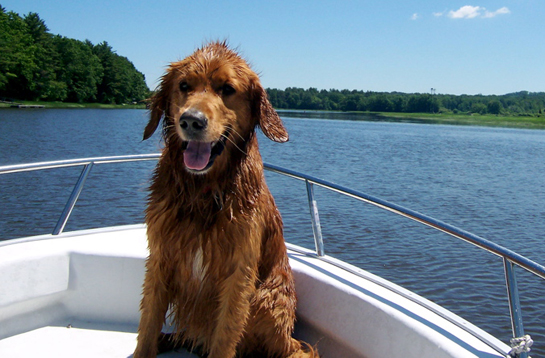 |
For most of us, our dogs are more than pets. They’re members of the family. So, naturally, when we go boating, we want to bring them along. And what could be better to a dog than being on a boat with the wind blowing in his face, bringing scads of scents into his fine-tuned nostrils? Then, when the air starts to swelter, the crew pulls the boat into a cove for a refreshing dog paddle in the cool water. Canine heaven! |
The good news is that dogs are generally go-anywhere pets. Most tend to adapt readily to new experiences and environments, even becoming eager participants in these adventures. But don’t mistake that unbridled enthusiasm for inbred boating know-how.
The first time boating with your dog should be short and sweet. Of course, until you train him to “go” on board, you’ll likely have to return to land every few hours anyway. If at any point it becomes obvious that your pet isn’t enjoying being on the boat — if you can get seasick, so can your pet — it’s kinder to leave him on land with a loving caretaker.
Tips & Advice
Assuming
your canine companion does enjoy boating with the family, you’re still
going to have to take precautions to keep him happy and safe. Here are a few
common tips that require only a little preparation ahead of time.
1.Dog-proof your boat. Take a dog’s eye view of the boat and gear. Make
sure there are no hazardous or dangerous materials within his reach. Nosy
pets in the fishing tackle can spell disaster!
2.Designate a potty area. You can be low-tech and use taped-down newspaper,
or you can purchase a special setup from your local pet store. Make sure your
dog goes to the bathroom before you set out, and bring plastic bags to clean
up after him.
3.Bring lots of food and water. It’s better to have too much food and
water than too little. This is especially true of water. Dogs regulate body
heat through panting, and while doing so, they lose large amounts of fluids.
Have a bowl on hand and enough water to fill it as often as the dog wants
to drink. Excessive panting, drooling and abnormally rapid pulse are danger
signs that you pet is overheating.
4.Find or create a shaded area on your boat where your pet can take shelter.
Hopefully, there will be air movement here to aid in cooling. Wetting his
coat with fresh water can also help him feel better. Too much time in the
sun and heat can cause problems such as sunstroke, cramps and heat exhaustion.
5.Protect the pads on his paws. Dogs absorb cold and heat through their pads
and can be burned by a boat’s hot fiberglass and vinyl surfaces. Purchase
a set of custom pad protectors, or brings sheets, blankets or towels for him
to walk and lie on.
6.Remember to check regulations in advance if you plan to venture to foreign
ports with your pet. Many places have quarantine/health laws that apply to
“foreign” animals.
7.Make sure you have an appropriately sized life jacket for your dog, especially
if he plans on entering the water. Contrary to popular belief, not all dogs
naturally know how to swim. It’s also a good idea to get a doggy boarding
ladder to help him enter and exit the water easily and safely on his own.
8.Develop an emergency procedure for your pet and practice it before taking
him out on your boat. It can be easy to overlook your dog’s needs when
the worst happens, so be prepared.
Taking a dog boating is not as difficult as it sounds. Most are great companions on boats and enjoy the experience. While bringing your dog along puts a little extra responsibility on the family, most boating pet owners agree that the payoff is well worth it.